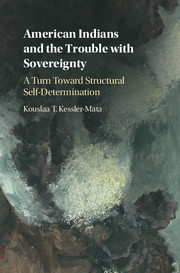Book contents
- American Indians and the Trouble with Sovereignty
- American Indians and the Trouble with Sovereignty
- Copyright page
- Dedication
- Contents
- Preface
- Acknowledgments
- 1 The Conceptual Limits of Tribal Sovereignty
- 2 Building the Constitutive Theory of Tribal Sovereignty
- 3 Regional Dilemmas: The Politics of Tribal–State Relations
- 4 Disabling Arbitrary Interference
- 5 Political Participation: A Hallmark of Incorporation
- 6 The Constitutive Theory as a Theory of Freedom
- Bibliography
- Index
- References
Bibliography
Published online by Cambridge University Press: 13 October 2017
- American Indians and the Trouble with Sovereignty
- American Indians and the Trouble with Sovereignty
- Copyright page
- Dedication
- Contents
- Preface
- Acknowledgments
- 1 The Conceptual Limits of Tribal Sovereignty
- 2 Building the Constitutive Theory of Tribal Sovereignty
- 3 Regional Dilemmas: The Politics of Tribal–State Relations
- 4 Disabling Arbitrary Interference
- 5 Political Participation: A Hallmark of Incorporation
- 6 The Constitutive Theory as a Theory of Freedom
- Bibliography
- Index
- References
- Type
- Chapter
- Information
- American Indians and the Trouble with SovereigntyA Turn Toward Structural Self-Determination, pp. 125 - 132Publisher: Cambridge University PressPrint publication year: 2017



